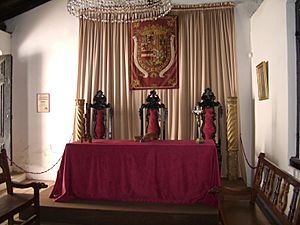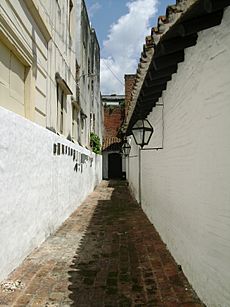Casa de la Independencia Museum facts for kids

Casa de la Independencia museum building
|
|
| Established | 14 May 1965 |
|---|---|
| Location | Asunción, Paraguay |
| Type | History museum |
The Casa de la Independencia Museum is a special history museum and historic house in Asunción, Paraguay. It's like stepping back in time to a very important moment for the country.
This museum opened on May 14, 1965. It shows many historical items from when Paraguay became independent. On the evening of May 14, 1811, a group of brave Paraguayans left this very house. They went to declare Paraguay's independence from Spanish rule. This house is a national monument because of its huge historical importance. Inside its walls, the plan to break free from Spain was secretly made. The museum is located at the corner of Presidente Franco and 14 de Mayo streets. It has a classic colonial style.
Contents
The Story of the House
This important house was built in 1772. A Spanish settler named Antonio Martínez Sáenz built it with his Paraguayan wife, Petrona Caballero de Bazán. The walls were made of adobe, which is like sun-dried mud bricks. The roof was thatched, and the frame used bamboo and palm wood.
Antonio and Petrona had two sons, Pedro Pablo and Sebastián Antonio. Both brothers inherited the house and lived there with their wives. Pedro Pablo was married to Carmen Speratti, and Sebastián Antonio was married to Nicolasa Marín. Carmen's sister, Facunda Speratti, and Nicolasa's sister, Virginia Marín, also lived there. This family became very important in Paraguay's history.
The house was also a place where important people stayed. Captain Pedro Juan Caballero often lodged here when he visited Asunción. Vicente Ignacio Iturbe, another patriot, lived nearby with his aunt. Captain Juan Bautista Rivarola Matto also stayed next door with his mother-in-law. Even Fulgencio Yegros and Lieutenant Mariano Recalde visited the Martínez house often. They were interested in Facunda Speratti and Virginia Marín.
Because of who lived there and its location, the Martínez brothers' house became the perfect secret meeting spot. Here, patriots planned how to gain independence from Spanish rule.
On the night of May 14, 1811, a group of men, led by Pedro Juan Caballero, used the alley next to the house. They walked to the Governor's house a few blocks away. Their goal was to make the Governor share his power. This was a big step towards independence!
Exploring the Rooms
The museum has several rooms, each filled with history.
The Office Room
In this room, you can see important documents from the independence period. Many patriots of Paraguay's independence signed these papers. There's also a special desk that belonged to Fernando de la Mora. You can also see five paintings. One painting is very famous; it shows the moment Governor Velazco was confronted, painted by Jaime Bestard.
The Dining Room
This room displays furniture and items that people used every day during the colonial times. You can see a sword that belonged to Fulgencio Yegros in one of the windows. There's also a striking portrait of Doctor José Gaspar Rodríguez de Francia, a very important figure in Paraguay's early history.
The Living Room
The living room features beautiful French furniture from the 1830s. It's lit by a crystal chandelier. There's also a brazier, which is a container for hot coals, made of wood and bronze. You can see two large portraits of Pedro Juan Caballero and Fulgencio Yegros. Religious statues made in Jesuits and Franciscan workshops also decorate the room.
The Bedroom
Here, you'll find a bed that belonged to Fernando de la Mora. His portrait hangs on the wall above it. Below the picture, there's an embroidered shirt he once wore. The room also has a large chest used by Juan Bautista Rivarola, a unique toilet, a beautiful prie-dieu (a kneeling desk for prayer), and a colorful niche (a wall alcove).
The Oratory
The Oratory is a small chapel-like room. It displays Jesuit and Franciscan carvings and various religious objects from different places. You can also see a portrait of the priest Francisco Xavier Bogarín here.
The Corridor
In the corridor next to the rooms, you'll find two large wooden boards. These were carved from old church doors from the missions. Below them are pieces of the house's original eaves, which are the parts of the roof that hang over the walls. These pieces help us understand how buildings were made long ago.
The Yard
The yard features a large mural painted by José Laterza Parodi. On this mural, you can read the text of a very important letter from July 20, 1811. This letter was sent to the Primera Junta in Buenos Aires and clearly stated Paraguay's independence.
Below the letter, you'll see the first coat of arms of the nation. This symbol was adopted during the time of Doctor Gaspar Rodríguez de Francia. At the bottom, there's a sundial from the Jesuit mission of Santa Rosa. In one corner of the yard, there's a small mound covering the remains of the patriot Juan Bautista Rivarola Matto. His remains were brought here from the cemetery in Barrero Grande, now called Eusebio Ayala.
The Capitulary Saloon
After crossing the yard, you enter a replica of the Capitulary Saloon. This was a main meeting room of the old Cabildo de Asunción. The Cabildo was the first city council in the Río de la Plata region, started on September 16, 1541. In the middle of the room, there's the coat of arms of Spain from 1800. On the walls, you can see a grand portrait of Emperor Charles V. Other pictures show different attempts at revolution that happened before Paraguay's independence.
The Historical Alley
You enter the Historical Alley through the door of the Capitulary Saloon. This alley is one of the most important parts of the house. It's where brave Paraguayan patriots walked to begin the country's independence. It was also through this alley that Juana Maria de Lara went to the Cathedral of Asunción. She asked Padre Molas for a special signal: the ringing of the bronze bells. When the bells rang on the morning of May 15, Paraguayans came out to celebrate. This was the historical moment when the new Republic of Paraguay was born!
More About the Museum
To remember that the country's independence was planned in this house, a special decision was made. During the government of Carlos Antonio López, a decree in April 1849 named the streets of Asunción for the first time. The street in front of the Historical Alley was named "14 de Mayo" (May 14).
At the museum's entrance, you can see a mural made by the ceramist José Laterza Parodi.
In 2003, 38 years after the museum opened, a person named Nicolás Darío Latourrete Bo visited. He saw that the museum was not in good condition and helped to restore it. In February 2003, work began to restore the building and preserve its valuable historical items. That same year, the Ministry of Culture and Education named Mr. Latourrete Bo the protector of the Independence House. In 2005, he was declared the "Life Protector" of the museum. This was a very special and unique honor in Paraguayan history.
Visiting Hours
You can visit the Museum "Casa de la Independencia" during these times:
- Monday to Friday: 7:00 a.m. to 6:30 p.m.
- Saturdays: 8:00 a.m. to 12:00 p.m.
See also
 In Spanish: Museo Casa de la Independencia para niños
In Spanish: Museo Casa de la Independencia para niños





